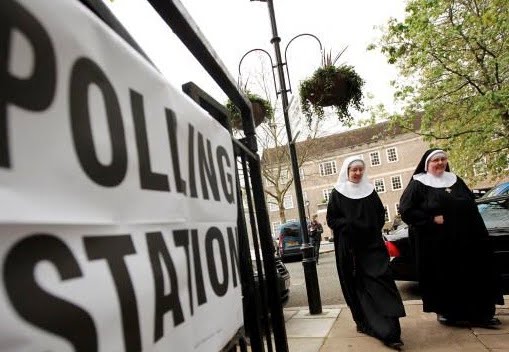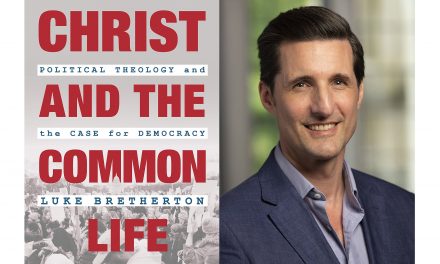The following is a guest post from Eli McCarthy, who teaches justice and peace studies at Georgetown University and is the Director of Justice and Peace for the Conference of Major Superiors of Men.
Pope Francis recently visited the Holy Land and made a surprise offer to the Presidents of Israel and Palestine to “an encounter of prayer” at the Vatican. He has energized a return to a deep reading of the signs of the times, which includes his focus on peacemaking, the poor and creation. One of the most challenging and exciting “signs of the times” is the trajectory of Catholic moral theology and social teaching for letting go of the concept of “just war” and turning to “justpeace” as the approach to moral analysis and engagement, particularly to acute conflict. I sense that the centrality of Mercy, which Pope Francis illuminates, invites us to complete this turn.
God’s promise that “justice and peace shall embrace” (Psalm 85:10) embodies the holistic vision of God’s Shalom, which reminds us that justice requires peace-making and that peace requires justice-making. Pope John Paul II illuminates this reality by extending the more popular phrase, “no peace without justice,” to “no peace without justice and no justice without forgiveness.”
Jesus models “justpeace” in caring for the outcasts, loving and forgiving enemies, challenging the religious, political, economic, and military powers, along with risking and offering his life on the cross to expose and transcend both injustice and violence. Jesus centers Shalom on the embodiment of mercy and compassion in the Good Samaritan story. Further, the “new commandment” from Jesus is to “love as I have loved you,” i.e. the nonviolent love of neighbor, strangers and enemies. With Jesus’ focus on healing and reconciliation, even with enemies, we learn that the kind of justice Christ turns us toward is restorative justice, i.e. focus on the wounds to relationships and how to heal.
With the Vatican II era re-appropriating Jesus as the center of moral theology, the re-turn to virtue ethics as a primary approach, and the extension of the call to holiness to the laity, we seem to have embarked on a fresh turning to justpeace. Pope John XXIII legitimated human dignity and human rights as integral to peace on earth. He held that it was “contrary to reason to consider war as a suitable way to restore rights.” Pope Paul VI illuminated that peace comes via development and the Church grew in addressing structural injustice. Pope John Paul II spoke of peace via development, rights, solidarity, and nonviolence, with specific declaration that “violence is evil” since it fails to defend human dignity. He says “violence is the enemy of justice,” and “only peace can lead the way to true justice.” In 1993, the U.S. Catholic Bishops acknowledge the nonviolent ethic as plausible for the public order as they raise increasing questions about “just war.” Pope Benedict proclaims that the love of enemies is the nucleus of the Christian revolution, with violence degrading the dignity of both victim and perpetrator.
Pope Francis has enthusiastically returned our attention to Jesus’ focus on mercy as the center of Shalom and the alternative to violence. He calls war the “suicide of humanity,” while calling us to “give up the way of arms.”
The turning to justpeace in the Catholic Church has been coupled with an ecumenical turning. The United Church of Christ, the United Methodist Church, and the World Council of Churches offer key examples. The WCC has recently produced an “Ecumenical Call to Justpeace” which declares the concept and the mentality of “just war” to be obsolete.
Theologians are raising further serious issues with the concept of “just war.” For example, in large part, it has proven ineffective in achieving its intended purpose, namely, limiting the scourge of war. In fact, it has much more often been used to “justify” war, particularly by political and military decision-makers. The “just war” concept also fails to cultivate the kinds of people that imagine and engage the broad-range of effective nonviolent peacemaking practices. In turn, we have created a culture that too often glorifies violent actors; and turns us away from the model of virtue and holiness, i.e. Jesus Christ.
In turn, key developments have occurred among U.S. theologians to support, integrate, and advance these signs of the times. Dr. Glen Stassen collaborated with other theologians in developing the “Just Peacemaking Theory,” which addresses the question “what practices have proven to prevent war?” They present this as the “new paradigm” to ethics of peace and war with ten key practices. Dr. Maryann Cusimano Love of Catholic University of America has developed the “just peace criteria” evolving from the insights of Catholic organizations such as Caritas International and Catholic Relief Services. She argues that these criteria apply to all stages of conflict. They include: just cause- dignity, life, common good; right intention- positive peace; participatory process; right relationship- vertical and horizontal; reconciliation; restoration- material, psychological, spiritual; and sustainability. These would function as criteria for determining specific actions or sets of actions we might choose in order to engage conflict before, during, or after violence breaks out.
Building upon Lisa Cahill’s Love Your Enemies and the U.S. Bishops Harvest of Justice is Sown in Peace, my argument in Becoming Nonviolent Peacemakers invites us toward a virtue ethic approach to “justpeace” by focusing us on the question “what kinds of people are we becoming?” I argue that this approach can also help us to focus on developing the virtuous character and core practices of peacemaking so that we are better prepared to imagine nonviolent ways to engage conflict, to choose, and to sustain those ways through difficult situations. Thus, in the spirit of the shared call to holiness, I argue for a distinct and central virtue of nonviolent peacemaking, cultivated by seven core practices. I define this virtue as a habit of realizing the goods of a conciliatory love that draws enemies toward friendship, and the truth of our ultimate unity and equal dignity. The corresponding practices include: creating and frequenting an optional Eucharistic prayer with explicit references to Jesus’ love of enemies, etc.; training/education in nonviolent peacemaking and resistance, including forming nonviolent peacemaking communities; attention to religious or spiritual factors, especially in public policy discourse, and intra/er-religious dialogue; constructive program or social uplift with particular focus on the poor and marginalized; conflict transformation and restorative justice approaches; unarmed civilian peacekeeping; and nonviolent civilian-based defense.
These theological developments relate in the following ways. Stassen’s practices are helpful in thinking about how to prevent war and how to hold governments accountable to these practices, particularly when they argue for engaging in a war. However, they do not directly address the “just war” criteria and the mentality this framework creates. Cusimano Love does address these criteria and offers an alternative that is more expansive across all stages of conflict as well as more conducive to actually cultivating a justpeace. Thus, in theory and practice they could directly replace the “just war” criteria.
My own research offers a specific virtue ethic with the focused question, “what kinds of people are we becoming?” along with a call for a distinct and central virtue of nonviolent peacemaking. Cultivating such a virtue would help us become the kinds of people who can be served by and apply well Cusimano Love’s justpeace criteria, and perhaps develop them if needed in the future. The core practices of this virtue would help fill out key ways of meeting these criteria across all stages of conflict.
This virtue also would amplify the development of character and the kind of imagination, which engages and creatively applies, extends, and even corrects the practices of Stassen’s just peacemaking theory. For instance, this virtue would include aspects that are missing from the JPT, such as care for creation and civilian-based defense. It would challenge the practice of merely reducing “offensive weapons” as both an unclear distinction and inadequate. Further, this virtue would better imagine alternatives, further marginalize and de-legitimate the use of violence, which some authors of JPT support as permitted within the UN’s responsibility to protect consensus. The just peacemaking practices may help prevent war, but the virtue of nonviolent peacemaking would do a better job of preventing and transforming violence, which ultimately strengthens the prevention of war. Most importantly, this trajectory draws us closer to Jesus’ way of nonviolent love of friends, strangers, and enemies.
Becoming virtuous and justpeace people requires communities of formation. Susan Thistlewaite has developed a “Just Peace Church” program, which includes the letting go of “just war.” This is a healthy model to build on, especially with the further integration of the justpeace criteria and the virtue of nonviolent peacemaking.
The turn to “justpeace” and away from “just war” also has significant implications for how we analyze public policy. Recent examples of drawing on the “justpeace” lens have been articulated regarding the issue of armed drones and the conflict in Syria.
May the God of Love grace our hearts to let go of the concept of “just war” and turn to “justpeace” and the way of Jesus’ merciful love of friends, strangers, and enemies.





I think the Just War theory in its Catholic variety is not at all obolete. Recently I proved that is being used in the Encyclical LaudatoSi’by Pope Francis. Also in the recent debate after the conference about non-violence hosted by the Vatican, the Ope reaffirmed the right ton self-defense.
The Just War Theory in its catholic variety is very frequently used by critics of spewcific unjust war. It still is a good instrument to unmask abuse of moral legitamcy of wars.